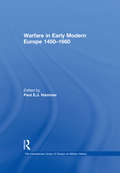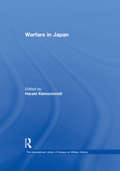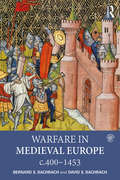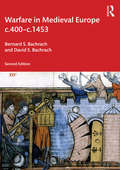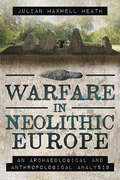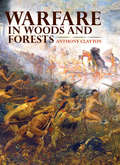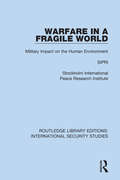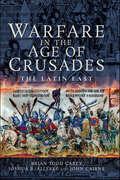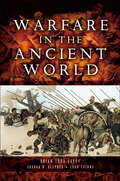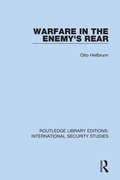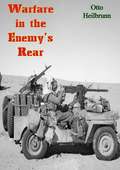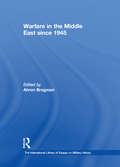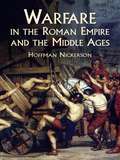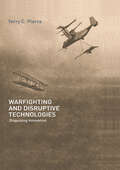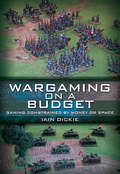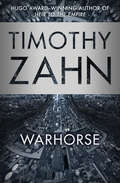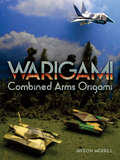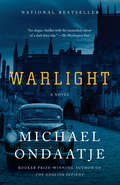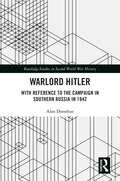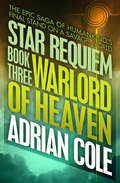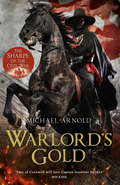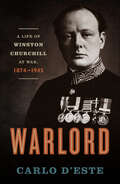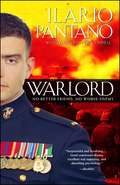- Table View
- List View
Warfare in Early Modern Europe 1450–1660 (The International Library of Essays on Military History)
by Paul E.J. HammerThe early modern period saw gunpowder weapons reach maturity and become a central feature of European warfare, on land and at sea. This exciting collection of essays brings together a distinguished and varied selection of modern scholarship on the transformation of war”often described as a ’military revolution’”during the period between 1450 and 1660.
Warfare in Japan (The International Library of Essays on Military History)
by Harald KleinschmidtWarfare in Japan from the fourth to the nineteenth century has caused much controversy among Western military and political historians. This volume assembles key articles written by specialists in the field on military organization, the social context of war, battle action, weapons and martial arts. The focus is on the transformation of patterns of warfare that arose from endogenous as well as exogenous factors.
Warfare in Medieval Europe 400-1453
by Bernard S Bachrach David BachrachWarfare in Medieval Europe c. 400-c.1453 provides a thematic discussion of the nature and conduct of war, including its economic, technological, social, and religious contexts, from the late Roman Empire to the end of the Hundred Years’ War. The geographical scope of this volume encompasses Latin Europe from Iberia to Poland and from Scandinavia and Britain to Sicily and includes the interaction between Europe and the eastern Mediterranean, particularly in the context of the crusading movement. Bernard and David Bachrach explore the origins of the institutions, physical infrastructure, and intellectual underpinnings of medieval warfare and trace the ways in which medieval warfare was diffused beyond Europe to the Middle East and beyond. Written in an accessible and engaging way and including chapters on military topography, military technology, logistics, strategy and combat, this is a definitive synthesis on medieval warfare. The book is accompanied by a companion website which includes interactive maps of the chief military campaigns, chapter resources, a glossary of terms and an interactive timeline which provides a chronological backbone for the thematic chapters in the book. Warfare in Medieval Europe is an essential resource for all students of medieval war and warfare.
Warfare in Medieval Europe c.400-c.1453
by Bernard S. Bachrach David S. BachrachWarfare in Medieval Europe, now in its second edition, offers considerably more attention to the transition from the later Roman Empire to the early Middle Ages, the composition of the armies of the opponents of the West, and the experience of commanders and individual combatants on the battlefield. This second revised and expanded edition provides a more in-depth thematic discussion of the nature and conduct of war, with an emphasis on its overall impact on society, from the late Roman Empire to the end of the Hundred Years’ War. The authors explore the origins of the institutions, physical infrastructure, and intellectual underpinnings of warfare, with chapters on military topography, military technology, logistics, combat, and strategy. Bernard and David Bachrach have also added a new chapter, which provides two detailed campaign narratives that highlight the themes treated throughout the text. The geographical scope of the volume encompasses Latin Europe, the Slavic World, Scandinavia, and the eastern Mediterranean, with a particular focus on the conflict between Western Christianity and the Islamic Near East. Written in an accessible and engaging way, Warfare in Medieval Europe is the ideal resource for all students of the history of medieval warfare.
Warfare in Neolithic Europe: An Archaeological and Anthropological Analysis
by Julian Maxwell HeathThe Neolithic ('New Stone Age') marks the time when the prehistoric communities of Europe turned their backs on the hunter-gatherer lifestyle that they had followed for many thousands of years, and instead, became farmers. The significance of this switch from a lifestyle that had been based on the hunting and gathering of wild food resources, to one that involved the growing of crops and raising livestock, cannot be underestimated. Although it was a complex process that varied from place to place, there can be little doubt that it was during the Neolithic that the foundations for the incredibly complex modern societies in which we live today were laid. However, we would be wrong to think that the first farming communities of Europe were in tune with nature and each other, as there is a considerable (and growing) body of archaeological data that is indicative of episodes of warfare between these communities. This evidence should not be taken as proof that warfare was endemic across Neolithic Europe, but it does strongly suggest that it was more common than some scholars have proposed.Furthermore, the words of the seventeenth-century English philosopher, Thomas Hobbes, who famously described prehistoric life as 'nasty, brutish, and short', seem rather apt in light of some of the archaeological discoveries from the European Neolithic.
Warfare in Woods and Forests
by Anthony ClaytonFighting in woods and forests is a very special form of war. Avoided by military commanders unless such terrain is to their advantage, for soldiers forest battles are a chaotic mix of dread, determination, and, all too often, death. Adversaries remain in constant fear of concealed ambush, casualties usually must be abandoned, and prisoners who cannot be guarded are killed. Heightened fear can lead to excesses. Too often, armies have been badly prepared and trained for such warfare and have suffered severely for it. In Warfare in Woods and Forests, noted military historian Anthony Clayton describes major events in woods and forest warfare from the first century CE to the 21st. These events involve Roman soldiers in Germany 2,000 years ago; North Americans in 18th- and 19th-century conflicts; invaders of Russia in 1812 and 1941; British, French, and Americans in France in 1916 and 1918; Americans in the Hürtgen Forest in 1944; and modern-day Russian soldiers in Chechnya.
Warfare in a Fragile World: Military Impact on the Human Environment (Routledge Library Editions: International Security Studies #21)
by SipriThis book, first published in 1980, examines the extent to which warfare and other military activities contribute to environmental degradation. The military capability to damage the environment has escalated. The military use and abuse of each of the several major global habitats – temperate, tropical, desert, arctic, insular and oceanic – are evaluated separately in the light of the civil use and abuse of that habitat.
Warfare in the Age of Crusades: The Latin East
by John Cairns Brian Todd Carey Joshua B. AllfreeWarfare in the Age of Crusades: The Latin East explores in fascinating detail the key campaigns, battles and sieges that shaped the crusading period of the Middle Ages, giving special attention to military technologies, tactics and strategies. Key personalities and political factors are addressed, including the role of papal monarchy in initiating the crusading expeditions, the relationship between Catholic Europe and the Byzantine empire, the role of the religious military orders, and Islamic and Mongol military capabilities. Chapters are devoted to each of the major crusades to the Levant – First, Second, Third and Fourth crusades – and an analysis of the Islamic response. The rise of the Mamluks in Egypt, with their innovative military organization, is covered, as are the failed Egyptian and Tunisian campaigns. The concluding chapters describe the Mongol campaigns in the Levant, the Mamluk response, and the final siege of Acre in 1291. This original and perceptive study of a key stage in medieval military history features regional, strategic and multi-phase tactical maps that illuminate the narrative and provide a valuable resource for students, historians and wargamers alike.
Warfare in the Ancient World
by John Cairns Brian Todd Carey Joshua B. Allfree“An interesting study of the development of military organization and strategy across several millennia, from Bronze Age Mesopotamia to the last days of Rome.” —The Pegasus ArchiveWarfare in the Ancient World explores how civilizations and cultures made war on the battlefields of the Near East and Europe between the rise of civilization in Mesopotamia in the late fourth millennium BC and the fall of Rome.Through an exploration of twenty-six selected battles, military historian Brian Todd Carey surveys the changing tactical relationships between the four weapon systems—heavy and light infantry and heavy and light cavalry—focusing on how shock and missile combat evolved from tentative beginnings in the Bronze Age to the highly developed military organization created by the Romans.The art of warfare reached a very sophisticated level of development during this three millennia span. Commanders fully realized the tactical capabilities of shock and missile combat in large battlefield situations. Modern principles of war, like the primacy of the offensive, mass, and economy of force, were understood by pre-modern generals and applied on battlefields throughout the period.Through the use of dozens of multiphase tactical maps, this fascinating introduction to the art of war during western civilizations ancient and classical periods pulls together the primary and secondary sources and creates a powerful historical narrative. The result is a synthetic work that will be essential reading for students and armchair historians alike.“An ambitious book that sets out to cover four and a half thousand years of military history, from the rise of the first civilizations in the Near East to the fall of the Western Roman Empire.” —History of War
Warfare in the Enemy's Rear (Routledge Library Editions: International Security Studies #22)
by Otto HeilbrunnThis book, first published in 1963, is an analysis of modern warfare in the enemy’s rear, written by the leading authority on irregular warfare, and stemming from a close examination of real-life examples. Rear warfare on scale poses many problems, such as the exact field of operations; supply line issues; combat or harassment; and coordination with frontline troops. There is also the issue of protecting one’s own rear troops.
Warfare in the Enemy’s Rear
by Otto HeilbrunnThis book, originally published in 1963, is a survey of history of special operations in World War II and in the Cold War, with substantial detailing on the elite Nazi Brandenburgers. The book covers tactics, techniques and procedures from various countries and how they wage special warfare in the enemies denied areas. A historically significant book in the study of modern special warfare, this title will appeal to the professional and armchair military historian and serving military personnel.
Warfare in the Middle East since 1945 (The International Library of Essays on Military History)
by Ahron BregmanFrom the end of the Second World War and throughout the era that came to be known as the Cold War, the Middle East was a battleground for Great Power rivalries and constant wars. These were fought between Israelis and Arabs, Arabs and Iranians, Arabs and Arabs and also between regional players and outside powers; the region was also the scene of several intense civil wars and insurgencies. The essays gathered in this volume focus on some of the most important facets of these Middle Eastern conflicts. Following a general introduction, the essays are then organised under three major sections. The first focuses on the Arab-Israeli conflict; the second on the Gulf Wars, and the third section concentrates on insurgencies. Together, these essays, all of which were written by leading experts, will provide the reader with a good introduction to warfare in the modern Middle East and show how conflict has shaped the region.
Warfare in the Roman Empire and the Middle Ages
by Hoffman NickersonComprehensive study of armed conflict, based on contemporary accounts and accompanied by illustrations and maps from rare sources, vividly describes dramatic changes in the art of war over 1,500 years -- from Roman rule through 565 AD, to war tactics during the Crusades. Fighting methods, supply systems, tactical organization, and more. 15 black-and-white illustrations.
Warfighting and Disruptive Technologies: Disguising Innovation (Strategy and History)
by Terry PierceOccasionally, during times of peace, military forces achieve major warfighting innovations. Terry Pierce terms these developments 'disruptive innovations' and shows how senior leaders have often disguised them in order to ensure their innovations survived.He shows how more common innovations however, have been those of integrating new technologies to help perform existing missions better and not change them radically. The author calls these 'sustaining innovations'. The recent innovation history suggests two interesting questions. First, how can senior military leaders achieve a disruptive innovation when they are heavily engaged around the world and they are managing sustaining innovations? Second, what have been the external sources of disruptive (and sustaining) innovations?This book is essential reading for professionals and students interested in national security, military history and strategic issues.
Wargames
by Martin Van CreveldWhere did wargames come from? Who participated in them, and why? How is their development related to changes in real-life warfare? Which aspects of war did they capture, which ones did they leave out, how, and why? What do they tell us about the conduct of war in the times and places where they were played? How useful are they in training and preparation for war? Why are some so much more popular than others, and how do men and women differ in their interest? Starting with the combat of David versus Goliath, passing through the gladiatorial games, tournaments, trials by battle, duels, and boardgames such as chess, all the way to the latest simulations and computer games, this unique book traces the subject in all its splendid richness. As it does so, it provides new and occasionally surprising insights into human nature.
Wargaming on a Budget: Gaming Constrained by Money or Space
by Iain DickieWargaming can be a very expensive hobby, but it needn't be. Iain Dickie, one of the best-known names in the hobby shares dozens of hints and tips on how to cut the cost of your gaming and get 'more bang for your buck'. He offers sound practical advice on buying and building your armies (should you opt for metal, plastic, or even card, and in which scale?), gaming tables, terrain, buildings and even storage solutions. As well as purely financial constraints, Iain Dickie also recognizes the fact that available space is another major restriction for many gamers and tackles this issue too. Now you've got no excuse not to get wargaming!
Warhorse
by Timothy ZahnThe Tampy aliens&’ living spaceships are far more powerful than humanity&’s non-biological technology. Can they—and should they—be tamed?Throughout the universe, space horses are among the most coveted of species. They are starfaring creatures with telekinetic abilities, tamed and controlled by the Tampy aliens—who aren&’t willing to share their understanding of the creatures. Despite diplomatic government intervention, human poachers are determined to capture and control the giant beings. With a tenuous peace treaty in place between the Tampy and humans, the first jointly helmed space horse will undertake its first mission. But will the two races be able to work together—or will their peace break down into all-out war?
Warigami: Combined Arms Origami
by Jayson Merrill"A very clever and impressive book of origami designs of military equipment. Great pictures, love the camo paper!" -- Clermont County Public LibraryOrigami enthusiasts with a particular interest in weaponry will appreciate this unique book, which presents instructions for folding fourteen war machines: six jets, three missiles, and five ground vehicles. Illustrated in full color, the step-by-step directions show how to assemble the models. Origami aircraft include a spy plane, strike fighter, and bomber, plus impaler, javelin, and harpoon missiles that can be mounted on some of the jets. Models of ground vehicles include the predator battle tank and guardian battle walker.
Warlight: A novel (Vintage International)
by Michael OndaatjeFrom the internationally acclaimed, best-selling author of The English Patient: a mesmerizing new novel that tells a dramatic story set in the decade after World War II through the lives of a small group of unexpected characters and two teenagers whose lives are indelibly shaped by their unwitting involvement. <P><P>In a narrative as beguiling and mysterious as memory itself--shadowed and luminous at once--we read the story of fourteen-year-old Nathaniel, and his older sister, Rachel. <P>In 1945, just after World War II, they stay behind in London when their parents move to Singapore, leaving them in the care of a mysterious figure named The Moth. <P>They suspect he might be a criminal, and they grow both more convinced and less concerned as they come to know his eccentric crew of friends: men and women joined by a shared history of unspecified service during the war, all of whom seem, in some way, determined now to protect, and educate (in rather unusual ways) Rachel and Nathaniel. <P>But are they really what and who they claim to be? And what does it mean when the siblings' mother returns after months of silence without their father, explaining nothing, excusing nothing? <P>A dozen years later, Nathaniel begins to uncover all that he didn't know and understand in that time, and it is this journey--through facts, recollection, and imagination--that he narrates in this masterwork from one of the great writers of our time. <P><b>A New York Times Bestseller</b>
Warlord Hitler: With Reference to the Campaign in Southern Russia in 1942 (Routledge Studies in Second World War History)
by Alan DonohueThis book is a study of Adolf Hitler in his role as military commander and strategist from the beginning of the Second World War until the end of 1942, examining in detail the campaign in southern Russia that year. The thesis challenges the post-war narrative of Hitler as a dilettante who was solely responsible for the strategic and operational errors that led to Germany’s defeat in the war. Instead, this research highlights that decisions made by Hitler with respect to such disparate themes as strategy, operations, logistics, intelligence, economics, air and naval power, and coalition warfare were generally sound if viewed from his perspective, even if they were not ultimately successful. It also gives an overview of his own ideas concerning all aspects of military affairs, such as intelligence, command and morale. The careful analysis of Hitler’s decision-making process offers a unique contribution to Second World War scholarship and moves beyond a superficial understanding that the war’s outcome was a result of Hitler’s ineptitude as a military leader. Warlord Hitler will appeal to postgraduates and specialists in military history, as well as general readers interested in a deeper study of the Second World War.
Warlord of Heaven (Star Requiem #3)
by Adrian ColeAn alien warlord embarks on his final purge in the third novel in the epic Star Requiem fantasy series following Thief of Dreams. Adrian Cole&’s acclaimed Star Requiem series welcomes readers to Innasmorn, a planet where the elements are worshipped as gods . . . and where mankind is considered the enemy. As the last remnants of humankind face extinction at the hands of a ruthless alien foe, the ultimate battle is building. The terrible Csendook destroyers have gathered in the Warhive, a huge gladiatorial arena, ready to vanquish their enemy. But as the fearsome warlord Auganzar relentlessly searches the galaxy for his victims, internal and external forces conspire to bring about an end to the bloody, thousand-year crusade. It is only on the planet of Innasmorn where the last refuge of humanity lives, and it is up to the young, courageous Ussemitus to take up arms and defend their right not just to survive . . . but to thrive. A gathering storm of chaos and destruction looms . . . and only the strong will live. Don&’t miss the entire Star Requiem quartet: Mother of Storms, Thief of Dreams, Warlord of Heaven, and Labyrinth of Worlds.
Warlord's Gold: Book 5 of The Civil War Chronicles (Stryker)
by Michael ArnoldWarlord's Gold, the fifth novel in The Civil War Chronicles, Michael Arnold's acclaimed series of historical thrillers, sees battle-scarred hero, Captain Stryker, 'the Sharpe of the Civil War' on a quest to recover lost treasure.Autumn,1643. As an increasingly bitter war rages across England, Captain Innocent Stryker leaves Oxford with orders to recover a lost treasure, vital to the success of the Royalist cause. But a seemingly simple mission to the remote Scilly Isles is soon jeopardised, for enemies lie in wait. A formidable Parliamentarian agent has been sent ahead of Stryker's force, intent on defeating Royalist plans. Feared by ally and enemy alike, he is a man whose determination is only matched by his hatred for Stryker.The quest for the gold takes Stryker across storm-ravaged seas, through enemy territory and finally to the Royalist stronghold of Basing House. And it is there that Stryker will face his most dangerous challenge yet.
Warlord: A Life of Winston Churchill at War, 1874–1945
by Carlo D'EsteAs riveting as the man it portrays, Warlord is a masterful, unsparing portrait of Winston Churchill, one of history’s most fascinating and influential leaders. “Epic. . . . A brilliantly exciting narrative. . . . D’Este has given us, finally, the lion not only in winter, but at war: impetuous, brazen, misguided, but indefatigable, indomitable, and magnanimous: the greatest and most energetic generalissimo of the 20th century.” —Boston GlobeCarlo D’Este’s definitive chronicle of Churchill’s crucial role in the major military campaigns of the 20th century, Warlord uses extensive, untapped archival materials to provide “a very human look at Churchill’s lifelong fascination with soldiering, war, and command.” (Washington Post)
Warlord: Broken by War, Saved by Grace
by Malcolm Mcconnell Ilario PantanoThis is the powerful true story of the Marine lieutenant who, having fought for his country in the first Gulf War, went on to professional success in finance, only to be compelled to reenlist in the wake of 9/11. Leaving behind an ex-model wife and two children, he served once again in Iraq -- and was charged by the U.S. military with murder. Ilario Pantano has always been a warrior at heart -- it's the force that drives him, that defines his core being and his life. But on April 15, 2004, just a few moments during the most violent and chaotic month in the Iraq War would change his life forever. On a raid in the Sunni hotbed of the Al Anbar province, Lieutenant Pantano shot and killed two Iraqi insurgents. Months later, while successfully leading Marines during the explosive surge in terrorist activity, including the battles for Fallujah, one of his own men disputed Pantano's self-defense claim in the Al Anbar shootings. Pantano was relieved of his command and charged with premeditated murder, a crime punishable by death. Now for the first time, in his own words, Pantano recounts his gripping and controversial story in Warlord, the memoir of a patriot who prepared to reenlist as the Twin Towers fell on September 11, 2001, ten years after his service as an elite Marine sniper and veteran of Desert Storm. Warlord is the story of an unconventional fighter who combined his professional and military experiences to protect the lives of his men and win both on battlefields and in the courtroom. In the face of a widely publicized military hearing, Pantano's family "attacked into the ambush," launching a Defend-the-Defenders campaign that was met with overwhelming support nationwide. Pantano was cleared of all charges. But most surprising of all, the heart of the patriot has not been embittered as he calls on his fellow Americans to stand strong in the face of our enemies. A harrowing, redemptive, and singular contribution to the literature of war, Ilario Pantano's inspiring story brings an unrivaled human dimension to the conflict in Iraq, to the unyielding idealism that drives its American fighting men and women, and to the unexpected consequences and uncompromised faith that can emerge from the brutal, chaotic, and irreversible nature of combat.
Warlord: Chronicles of the Warlands Book 3 (GOLLANCZ S.F.)
by Elizabeth VaughanLara of Xy and her Warlord, Keir of the Cat, have been through much together. Lara left her homeland and her people for him, adopting his tribe as hers and learning their ways. Together they have overcome great trials, faced plague and insurgency, and found joy and happiness in each other's arms. But now they face their most arduous trial: Keir must take Lara into the Heart of the Plains, where she will be tested and examined by the warrior-priests. For Lara is the Warprize, but if the elders are to confirm her in her role, she must be accepted by a people who loathe everything she represents. And if she is found wanting, she will lose everything: her new home, her new people - and her Warlord . . .
